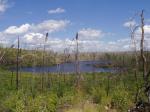BWCA Entry Point, Route, and Trip Report Blog
July 18 2025
Entry Point 52 - Brant Lake
Brant Lake entry point allows overnight paddle only. This entry point is supported by Gunflint Ranger Station near the city of Grand Marais, MN. The distance from ranger station to entry point is 45 miles. Access is a canoe landing at Round Lake with an 85- and a 35-rod portage to Brant Lake. This area was affected by blowdown in 1999.
Number of Permits per Day: 4
Elevation: 1500 feet
Latitude: 48.0692
Longitude: -90.8455
Brant to Tuscarora via Little Sag Route:
Round
Brant
Bat - Mud
Gillis - burn area is evident:

French
Peter - first lake trout:

Virgin
Little Sag - green trees again!
Mora - gorgeous divide of burn and green
Crooked
Owl
Tuscarora - second lake trout!
Missing Link - with lighter food pack, the portage is OK
Round
Number of Permits per Day: 4
Elevation: 1500 feet
Latitude: 48.0692
Longitude: -90.8455
Brant to Tuscarora via Little Sag Route:
Round
Brant
Bat - Mud
Gillis - burn area is evident:

French
Peter - first lake trout:

Virgin
Little Sag - green trees again!
Mora - gorgeous divide of burn and green
Crooked
Owl
Tuscarora - second lake trout!
Missing Link - with lighter food pack, the portage is OK
Round
College bros
by smalltown
Trip Report
Entry Date:
January 11, 2014
Entry Point:
Seagull Lake Only
Number of Days:
4
Group Size:
3
Trip Introduction:
Tyler and I worked the summer at a local outfitter and
decided to do a Winter trip with are first customer for
K&K Adventures.
Report
http://youtu.be/1kPlqdfngTQ
If you want to watch best BWCAW trip iv had but the video is 20 mins Enjoy!
discuss this trip report (9 comments) - last post on September 03, 2022

